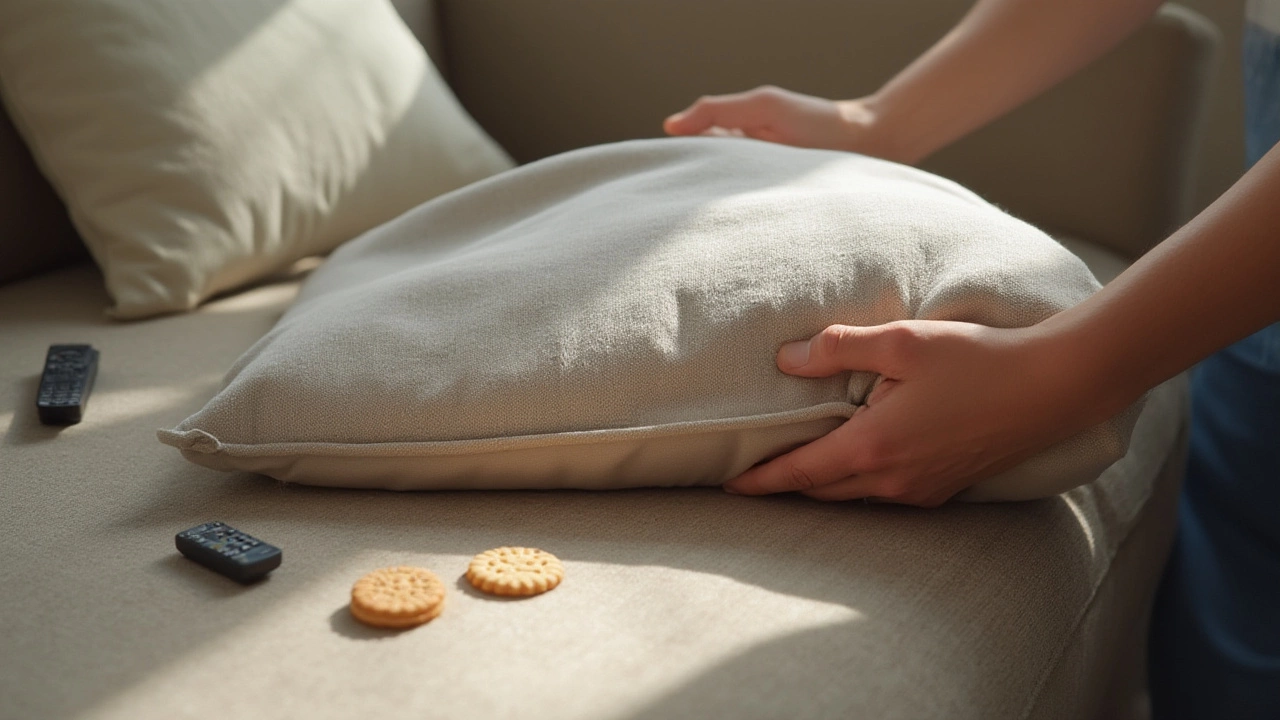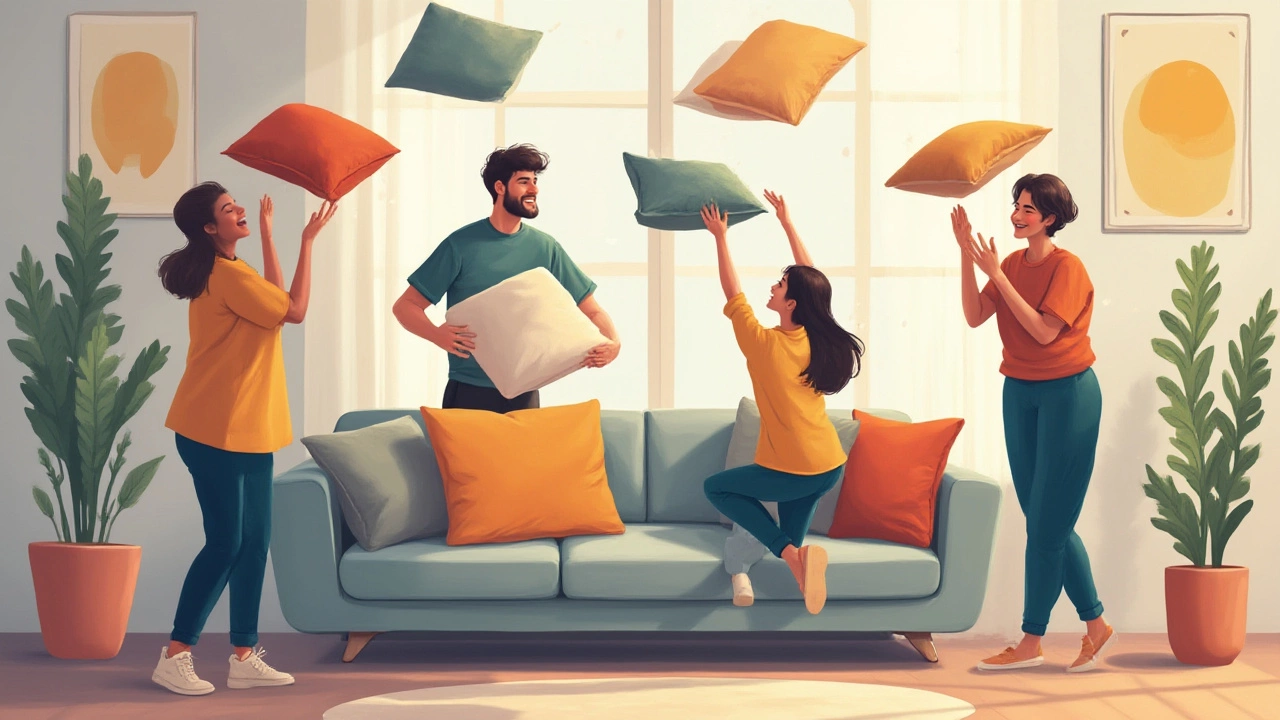Why Flipping Couch Cushions Matters for Your Sofa’s Lifespan and Comfort
 Jul, 6 2025
Jul, 6 2025
You know that squishy end of the couch everyone sinks into after a long day? If it’s gone a bit flat or sad, you’re not alone. That lopsided dip—that groove from movie marathons and endless scrolling—can sneak up on you. Most folks don’t give it much thought, but what you do (or don’t do) with your couch cushions can change the game in your living room. It sounds trivial, right? But the secret to a longer-lasting, comfier sofa actually lies in one old-school trick: flipping your cushions. It might just be the easiest hack for making your lounge feel better while saving money on repairs or replacements down the track.
What Happens When You Don’t Flip Your Couch Cushions?
Ignoring your couch cushions works for a while—until it really doesn’t. You’ll see the tell-tale signs: flat spots, saggy corners, and covers stretched thin from years of everyone’s favorite seat never catching a break. Gravity plus your body weight equals wear and tear, and fabric tends to give up when you keep planting yourself in the same spot day after day. Once you get those pancakes where there used to be plush, it’s tempting to blame shoddy craftsmanship. But sofas—especially ones you buy these days—aren’t exactly built like tanks anymore. According to the Consumer NZ 2024 survey, the average New Zealand household replaces their lounge suite every 8 years, but a well-cared-for one can last twice as long. That’s a massive difference in a world where furniture can cost a pretty penny.
There’s a science to it too. Polyurethane foam, the stuff inside most cushions, slowly compresses under constant pressure. The cells in the foam break down faster where you sit all the time—it’s like the difference between old trainers and new ones. If you don’t move things around, you’ll get those permanent dents. Once deep troughs appear, you’re chasing your own tail with fluffing or pillow inserts. Skipping the flip also does a number on the upholstery itself. Those stretched seams and fabric pilling? Blame habits, not just the dog leaping on the sofa. Plus, in Auckland's famously humid autumns, uneven wear can trap moisture and even encourage a musty smell.
Some folks reckon fancy couches don’t need this kind of fuss, but even the priciest sofas aren’t immune. In fact, the pricier ones that use soft natural materials can get dented even faster. Leather lounges skip out on the fabric-stretch problem but still show saggy padding if you don’t rotate. And let’s not forget: once those indentations set in, explaining it away as 'vintage charm' only works for so long. If you want a fresh-looking, firm-feeling couch, flipping is non-negotiable. Even if you only use your lounge for Netflix and board games, regular cushion-shuffling is worth the small effort.

Flipping vs. Rotating: What’s Actually Best (And How to Do It Right)
Flipping cushions isn’t the only power move in couch care. Rotating—switching cushions around from one spot to another—does practically the same trick. The real genius is mixing up the direction of the wear. For most sofas, you want to flip (turn the cushion over) if it’s two-sided and rotate (move it along the row, left to right or vice versa) so the same spots don’t get hammered all the time. The ideal method? Do both. Household experts, like those at Consumer NZ, say for standard foam or fibre cushions you should flip them every two weeks and rotate them once a month. In reality, most Kiwis manage it about every eight weeks—still better than never.
Here’s a hands-on system for you:
- Check if your cushions are actually double-sided. Some cheaper couches have a lining or sewn-in tags on the bottom—don't flip those ones, or you'll laugh when sitting down and realize the tags are poking you the rest of the night. If you do have reversible cushions, go for gold.
- When flipping, brush off crumbs and give the covers a quick vacuum. Auckland pollen and pet hair sneak in fast, so get rid of it before turning things over.
- Rotate end cushions with middle ones if the sizes fit. Main seats get the most traffic, so spread the love.
- Don’t forget your backrest cushions—these take a beating from dropped heads and arms. If they’re removable, rotate and flip them too.
- If you’ve got feather or down-filled cushions, give them a good fluff by squeezing and smacking them to restore loft. Foam cushions benefit from an occasional “knead” to break up compressed areas.
There’s actually a practical schedule for couch care. Here’s the short version:
| Task | Frequency | Benefit |
|---|---|---|
| Flipping cushions | Every 2-4 weeks | Keeps shape even |
| Rotating cushions | Monthly | Spreads wear |
| Vacuuming | Weekly | Removes debris/allergens |
| Deep cleaning | Every 6 months | Refreshes covers |
| Spot cleaning stains | As needed | Prevents set-in marks |
Kids and pets? You’ll need to flip more often, trust me. Also, in homes with direct sunlight (Auckland's sunny winters can surprise you), move cushions around to avoid faded patches. In open-plan spaces, move individual cushions from spot to spot for an unfair advantage—no one will guess which part is 'your' go-to Netflix zone.

Surprising Benefits and Extra-Pro Tips for Couch Cushion Longevity
Here’s the kicker—besides comfort and appearance, flipping cushions has another sneaky perk: keeping your home healthier. All those hidden crumbs, dust mites, and pet hairs work their way into the seams. Flipping cushions disrupts their cozy nest and lets you vacuum them out. This is a lifesaver for anyone with allergies. The Asthma and Respiratory Foundation NZ has flagged soft furnishings as a major trap for dust and pollen—especially in coastal cities where windows stay open most months. Making flipping part of your standard cleaning routine gives you a much better shot at fewer sniffles and less sneezing.
You also don’t want to ignore stains. Catching a spill under a flipped cushion weeks later turns a quick fix into a story you tell guests to distract from the mark. Whenever you flip, check for hidden spots. Auckland is famous for surprise rainy days and muddy shoes—perfect storm for unexpected, hard-to-find stains. For stubborn ones, a paste of baking soda and water works on most fabric cushions, but always test on the underside first. Leather owners: a damp cloth (no soap) does wonders, as does a tiny dot of vinegar for tough marks.
Here’s another tip: add a thin, breathable layer between the foam and the cover. Some older Kiwis swear by calico or even a basic cotton pillowcase. It slows down fabric wear and can be chucked in the wash. And if the family dog or cat can't resist snoozing on the good side, keep a stylish throw draped over the area they love most. You’ll thank yourself next time you flip and see the pet hair stays on the throw.
Ever heard that sitting in the same spot wrecks the bottom springs of your sofa? It’s actually true. Uneven compression makes some coils or webbing slacken much faster, especially on modern sofas that use multi-layered bases and not solid wood. Flipping and rotating spreads the pressure, saving those support bits from giving out too soon. Repairs to the internal frame or springs can cost hundreds of dollars—far more than the 5-minute effort it takes to shuffle cushions.
If you want an even longer-lasting couch, avoid flopping down hard day after day—that 'trust fall' move wears out the seat. Teach kids to hop (not jump) up, and try to keep heavy items off the sofa overnight. A rolled up towel or pillow placed under sagging cushions between flips can sometimes coax them back into shape. It might seem a bit old-fashioned, but these little tricks make a world of difference.
Here’s a challenge: next time you flip and rotate, snap a quick photo of each cushion’s top and bottom. It’s amazing how small differences add up over the months. If you spot one sitting lower, you can address it fast rather than waiting until it’s a disaster zone of lumps and dips. Consider it home maintenance, not just obsessive cleaning. Your wallet, your allergies, and your Netflix marathons will all quietly appreciate it.
Turns out, the answer is simple. Should you flip your couch cushions? If you care about comfort, looks, or just not spending on a new couch every few years, the answer’s as clear as the winter light across Auckland Harbour: flip, rotate, and keep your sofa feeling sharp. Couch maintenance isn’t just an old wive’s tale—it’s a proven way to get more life out of your favorite seat.